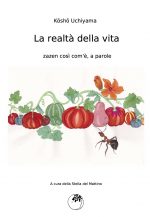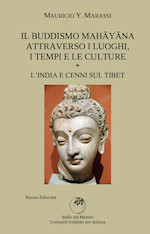I believe that emptiness is a critical dimension of inspiration for Buddhist art. To explain why let me remind that emptiness is not nothing and can either describe an absence or constitute the inner quality of fullness, or both.
In the 5th century b.C., this ambivalent nature of emptiness was underscored by the great Indian grammarian Panini. Using formulae to describe the morphology, syntax and phonetics of Sanskrit, Panini noted that the words “without prefix” convey a meaning that is different from what it would be if the prefix were there and concluded that this absence had a value. It was the birthday of zero, not as “nothing” , but as the value of emptiness.
Five hundred years later, Nagarjuna, founded the first Buddhist philosophical school, identified with unthought emptiness, sunya in Sanskrit, the Middle Way that Buddha had taught in Varanasi in his first sermon. Parenthetically, in the 7th century, this very word, sunya, with the circular sign that represented it came to the West under the Arab word sifr where it changed its name into zephirum first and into zero afterwards and finally.
It was essentially thanks to Nagarjuna’s school, called Madhyamika, or the Middle Way that Buddhism avoided the risk of assimilation when, in his long travel towards the East, it met the great Chinese culture in the 1st century a.D.. Buddhism could have easily melted into the sea that had, or thought to have, fathomed the deepest recesses of the human soul. However, Sakyamuni’s offer was too original and innovative to allow itself to be closed in and smothered by old religious forms. So, in the 4th century, it freed itself from the fetters of syncretism. As a result, when, in the 6th century, Bodhidharma, brought to China from India the living and unmediated form of the Way, found the ground already prepared by the Middle Way proposed by Nagarjuna, with its deep awareness of the emptiness and impermanence of every form of life and every phenomenon.
However, the cultural ground where the new school — called Chan in China and Zen in Japan — took its first steps and grew to adulthood, was steeped in Confucianism and Taoism. The a-religious essentiality of Zen resonated with the misanthropic naturalism of Taoism. Given over to reading the book of nature, Taoism supported and followed the course of nature without harming anyone. Therefore, in the 8th century, the first Chan monks who tried to express the ineffable they perceived in their daily lives, through painting and rhyming, borrowed the forms and the ambience of the idealized life of the Tao hermits and added to them, in a manner of speaking, the sense of the emptiness and transience of life. In the new aesthetic canon that emerged from this contamination, the Taoist hermits, the mythical sennin 1, and nature were taken as the models.
Many of the artists who created these paintings in China ink and the poets who wrote comments on them were Chan monks. Having steadfastly practiced zazen2 for many – even thirty or forty – years, they had dropped away body and mind and were living their most inner life, without interference from mental constructions. They had a direct and lucid experience of true life and of the infinite potentiality of emptiness. Their art derived from this religious experience, and therefore did not contain “sacred” or “devotional” images. Sanctity and devotion were the language spoken by very humble subjects– a stone or a grass tuft –as if lost in a vast empty space, like the mysterious beginning of life in the immensity of the cosmos.
Sometimes, the figures represented in these paintings were still Indian in origin: the most famous bodhisattva or Bodhidharma himself. But they were completely metamorphosed. Their traits were apparently coarse, their beards and hair unkempt and their sullen, almost angry countenance expressed stability, strength and mystery. Other times we see cheerful vagabonds jeering at the moon or heaping up dead leaves with twig brooms. The dragon, which is a symbol for the living mystery, can be glimpsed through the edges of fog banks or while it peeps from the dark bottom of a cave.
Since the 13th century, this simple and straight art made its appearance in Japan. As it had been in China, the finest artists were Chan – Zen in Japanese – monks. Their style was characterized by the essentiality and the absolute individuality of the stroke. Their subjects, essentially drawn from nature, clearly gave off a subtle sense of poignancy and melancholy at time fleeting away: a petal falling off from the corolla, the outline of a far away mountain becoming indistinct, a bird’s flight more intuited than seen. The most delicate and sensitive streak of Japanese culture understood and reproduced this sense and these images unerringly.
From the 15th century onwards, aesthetic refinement has permeated the Japanese intellectual elites and has contributed to the birth of those methods for personal realization that are based on the beauty of the gestures and the harmony of forms. This has given rise to a sort of lay religiosity, in that it has religious origins, but it expresses them according to secular aesthetic canons. The art of serving tea, Ikebana 3, calligraphy, No theatre, architecture and interior decoration are the visible expressions of the penetration in Japan of the aesthetics born of Buddhism. But it is important to underline that this aesthetics was critically different from that of the period immediately preceding it — that is before the 13th to 15th century — in its religious significance.
The absence of clear religious symbols and of images taken from the pantheon of a religion, ceased to belong to a form of art that prefers to suggest than to say explicitly, to imply the divine without bringing it on stage. Little by little, this changed, slowly but unfalteringly. The sparrow, the flower, the portrait of the ascetic, became the true subject of art. Religious figures, bodhisattvas and gods came back again, but as subjects of a sort of Mannerism. It may be beautiful; but, without the inexpressible something that created it, it does not move us any longer. The fertilization of lay aesthetic sensitivity through the art born of Buddhism had a very positive impact on Japanese society as a whole, but this was the beginning of the end of art of Zen as a religious expression.
| « Buddhist rituals | Back to Summary » |
[1] The word here in Japanese because it is better known in this language. The Chinese equivalent, in Pinyin transliteration, is xian.
[2] In Chinese, zuochan, the practice brought to China by Bodhidharma, which consists simply in sitting facing the wall, motionless and in silence.
[3] Literally: “life-flower”.
Se volete, lasciate un commento.
You must be logged in to post a comment.







